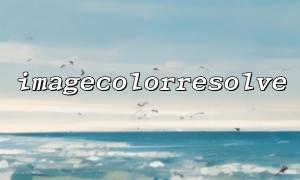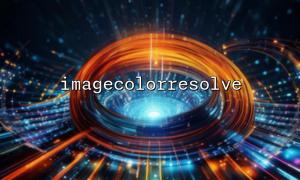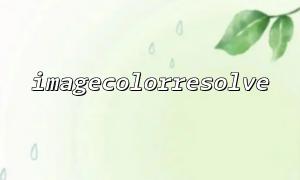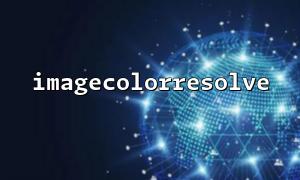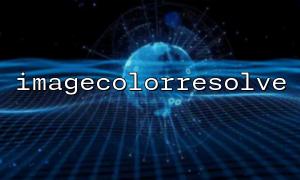When working with images using PHP's GD library, imagecolorresolve() is a common function that is used to find the closest color index in an image resource. If you encounter imagecolorresolve() failure in development, especially when image types are incompatible, there are usually several key reasons behind this. Below we will analyze the reasons in depth and provide troubleshooting and solutions.
imagecolorresolve() requires that the incoming image resource must be a palette-based image, such as a GIF or 8-bit PNG. If you are passing in a true color image , such as a resource created by imagecreatetruecolor() , then imagecolorresolve() will likely fail, returning -1 , indicating that the appropriate color index cannot be found.
Because true color images store color values independently based on each pixel, instead of using a color table, imagecolorresolve() needs to look for colors in the palette, which is naturally not found and is not supported in function design.
Let's give a simple example:
<?php
// Create a true color image
$image = imagecreatetruecolor(100, 100);
// Try to parse the color
$color = imagecolorresolve($image, 255, 0, 0);
if ($color == -1) {
echo "Cannot find color,Maybe the image type is incompatible。";
}
?>
This code will output an error message because imagecreatetruecolor() creates a true color image .
Confirm image type <br> Use imageistruecolor() to check if the image is a true color image.
if (imageistruecolor($image)) {
echo "The current image is truecolor,Can't be used directly imagecolorresolve()。";
}
View error log
The PHP runtime usually records warnings like "Image type is truecolor" in the error log. It is recommended to turn on display_errors and view them in the development environment.
Manually check source code <br> If the image is loaded from an external source (for example, imagecreatefromjpeg() , imagecreatefrommpng() ), pay attention to the default processing method of different formats. For example, the loaded PNG might be a 24-bit true color instead of an 8-bit palette image.
The most direct way is to use imagetruecolortopalette() to convert true color images into palette images.
<?php
$image = imagecreatetruecolor(100, 100);
// Convert to palette image
imagetruecolortopalette($image, false, 256);
// Now safe to use imagecolorresolve()
$color = imagecolorresolve($image, 255, 0, 0);
echo "The color index is:$color";
?>
Note : The parameter dither (jitter) is set to false during conversion, otherwise a noise effect will be introduced; ncolors specifies the number of colors (usually 256).
If you do not want to convert images, you can directly use imagecolorallocate() to assign colors on true color images, rather than imagecolorresolve() .
<?php
$image = imagecreatetruecolor(100, 100);
// Directly assign colors
$color = imagecolorallocate($image, 255, 0, 0);
if ($color === false) {
echo "Color allocation failed。";
} else {
echo "Color distribution successfully,The color index is:$color";
}
?>
imagecolorallocate() is suitable for palette images and true color images, so it is more general.
Suppose we process an image loaded from the URL https://m66.net/uploads/image.png :
<?php
$imagePath = 'https://m66.net/uploads/image.png';
// Loading the image
$image = imagecreatefrompng($imagePath);
// Check if it is true color
if (imageistruecolor($image)) {
// Convert to palette image
imagetruecolortopalette($image, false, 256);
}
// Now available imagecolorresolve()
$color = imagecolorresolve($image, 0, 128, 255);
if ($color == -1) {
echo "Color parsing failed。";
} else {
echo "Color index was found successfully:$color";
}
?>
In this way, we can be compatible with different types of images to avoid imagecolorresolve() errors.
The most common reason for imagecolorresolve() failure is the incompatible image types. As long as you follow the following two steps to investigate, most problems can be quickly located and fixed:
First check whether the image type is true color;
Choose to convert the image type, or use a more suitable function (such as imagecolorallocate() ).
In this way, you can process various images more stably and avoid difficult-to-position errors in the production environment.




